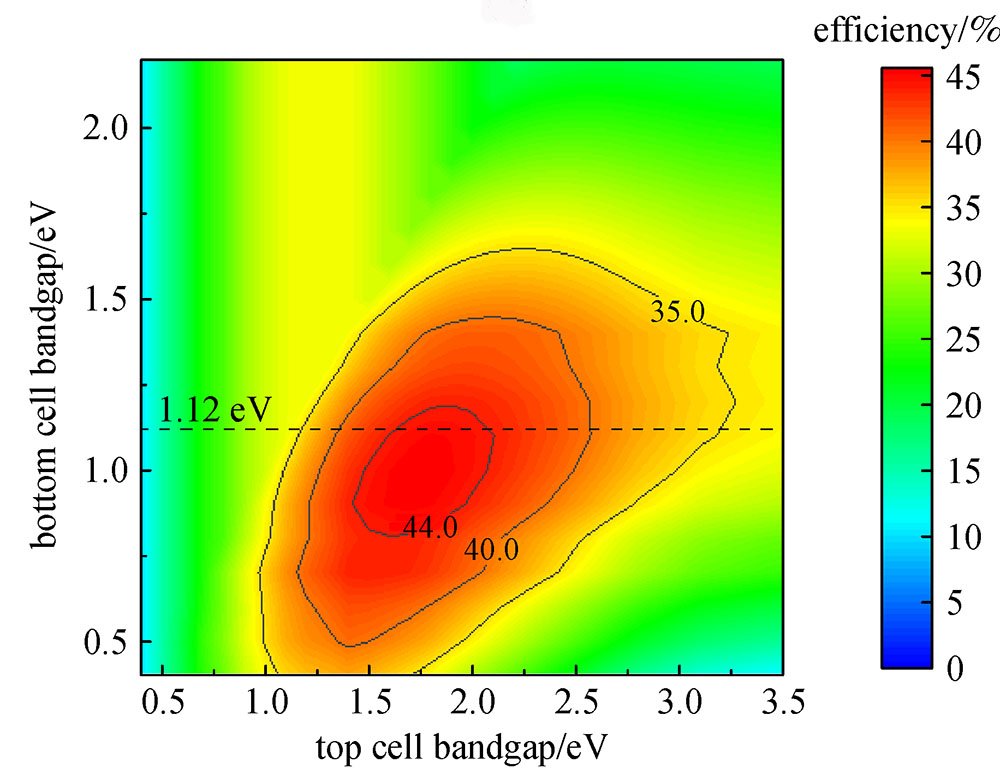Introduction

Fig.1 (a) Evolution of global cumulative installed capacity and percentage of global annual production of three major photovoltaic technologies: thin-film, multi-Si, and mono-Si. Adapted from Refs. [1,2]. (b) Photovoltaic module price evolution versus cumulative production. Adapted from Ref. [2]. (c) Record efficiencies of c-Si solar cells and their theoretical efficiency limits [3–5]. (d) Theoretical efficiency limit of four-terminal tandem solar cells as a function of the bandgaps of top and bottom cells based on the Shockley–Queisser limit |
Si-based tandem solar cells
III-V semiconductors as top cell
Wide-bandgap perovskites as top cell
CdTe and II-VI alloys as top cell
CIGS-related compounds as top cell
A-Si as top cell
Tab.1 Summary of notable results on Si-based tandem solar cells. All these solar cells were characterized under a AM 1.5G spectrum (1000 W/m2). The double slash (//) means that subcells are mechanically stacked, whereas a single slash (/) denotes that subcells are integrated by monolithic growth. 4T and 2Tare abbreviations for four-terminal and two-terminal tandem structures, respectively. NA means that the data are not available |
| device structure | PCE/% | VOC/V | JSC/(mA·cm−2) | FF/% | area/cm2 | test center, date | note |
|---|---|---|---|---|---|---|---|
| GaAs//Si (1.42//1.12 eV) | 32.82 | 1.092//0.683 | 28.90//11.07 | 85.0//79.2 | 1.003 | NREL, 12/2016 | NREL/CSEM/EPFL, 4T [15] |
| GaInP//Si (1.81//1.12 eV) | 32.45 | 1.454//0.694 | 15.78//23.11 | 87.0//77.9 | 1.005 | NREL, 12/2016 | NREL/CSEM/EPFL, 4T [15] |
| GaAsP/Si (1.72/1.12 eV) | 20.1 | 1.673 | 14.94 | 80.3 | 3.940 | NREL, 05/2018 | OSU/SolAero/UNSW, 2T [19] |
| AlGaAs/Si (1.6/1.12 eV) | 25.2 | 1.55 | 27.9 | 58 | 1 | not certified, 04/2012 | UTokyo, 2T [20] |
| GaInP/GaAs//Si(1.81/1.42//1.12 eV) | 35.91 | 2.520//0.681 | 13.61//11.03 | 87.5//78.5 | 1.002 | NREL, 02/2017 | NREL/CSEM/EPFL, 4T [15] |
| GaInP/AlGaAs/Si(1.90/1.43/1.12 eV) | 34.1 | 3.177 | 12.4 | 86.4 | 3.987 | FhG-ISE, 08/2019 | FhG-ISE, 2T [7,21] |
| GaInP/GaAs/Si(1.90/1.43/1.12 eV) | 24.3 | 2.662 | 12.2 | 74.5 | 3.987 | FhG-ISE, 06/2019 | FhG-ISE, 2T [7,22] |
| perovskite/Si | 28.0 | 1.802 | 19.75 | 78.7 | 1.03 | NREL, 12/18 | Oxford PV, 2T [7] |
| perovskite/Si(1.67/1.12 eV, CsFAMAPbIBrCl) | 27.13 (26.08) | 1.886 (1.87) | 19.12 (18.4) | 75.3 (74.9) | 1 (0.999) | not certified, 2019 (NREL, 08/2019) | CU/NREL/USTC, 2T [16] |
| perovskite/Si(1.68/1.12 eV, CsMAFAPbIBr) | 25.71 | 1.781 | 19.07 | 75.36 | 0.832 | FhG-ISE, 03/2020 | UofT/KAUST/NREL/SDSU, 2T [23] |
| perovskite/Si(1.63/1.12 eV, CsFAMAPbIBr) | 25.43 | 1.792 | 19.02 | 74.6 | 1.088 | FhG-ISE, 02/2019 | HZB/Oxf/Oxford PV, 2T [24] |
| perovskite/Si(1.6/1.12 eV, CsFAPbIBr) | 25.24 | 1.788 | 19.53 | 73.1 | 1.419 | FhG-ISE, 06/2018 | EPFL/CSEM, 2T [25] |
| perovskite//Si(1.72//1.12 eV, CsFAPbIBr) | 27.1 | 1.22//0.678 | 15.4//24.1 | 70.1//81.2 | 0.13 | not certified, 12/2018 | IMEC/KU Leuven/UG/TU/e, 4T [26] |
| CdZnTe/Si (1.78/1.12 eV) | 16.8 | 1.75 | 16 | 60 | NA | not certified, 01/2010 | EPIR, 2T [27,28] |
| CuGaSe2/Si(1.7/1.12 eV) | 5.1 | 1.32 | 9.0 | 43 | NA | NREL, 03/2003 | NREL, 2T [29] |
| CuGaSe2/Si(1.7/1.12 eV) | 9.7 | 1.328 | 12.3 | 59.4 | 0.5 | not certified, 11/2017 | KIST/UST [30] |
| a-Si//Si(1.7//1.12 eV) | 16.8 | 0.867//0.545 | 13.4//23.2 | 61.0//76.6 | 0.033 | not certified, 05/1990 | Osaka University, 4T [31] |
| a-Si/Si(1.7/1.12 eV) | 15.04 | 1.478 | 16.17 | 63.0 | 0.065 | not certified, 05/1990 | Osaka University, 2T [31] |
Potential candidates as top cell for Si-based tandems
Tab.2 List of potential candidates for use in Si-based tandem solar cells |




